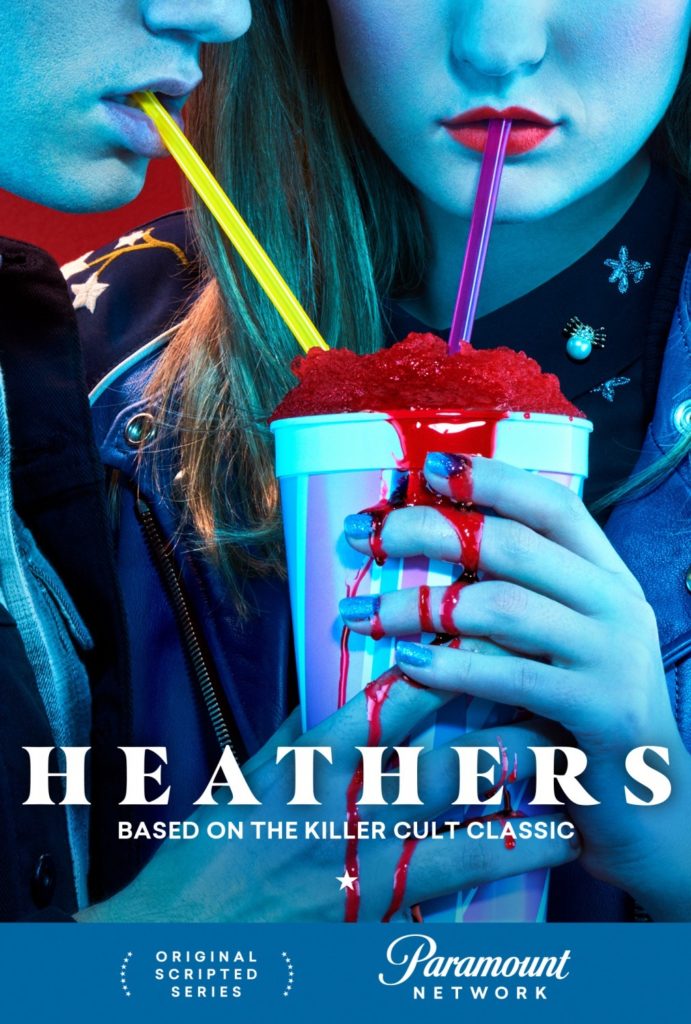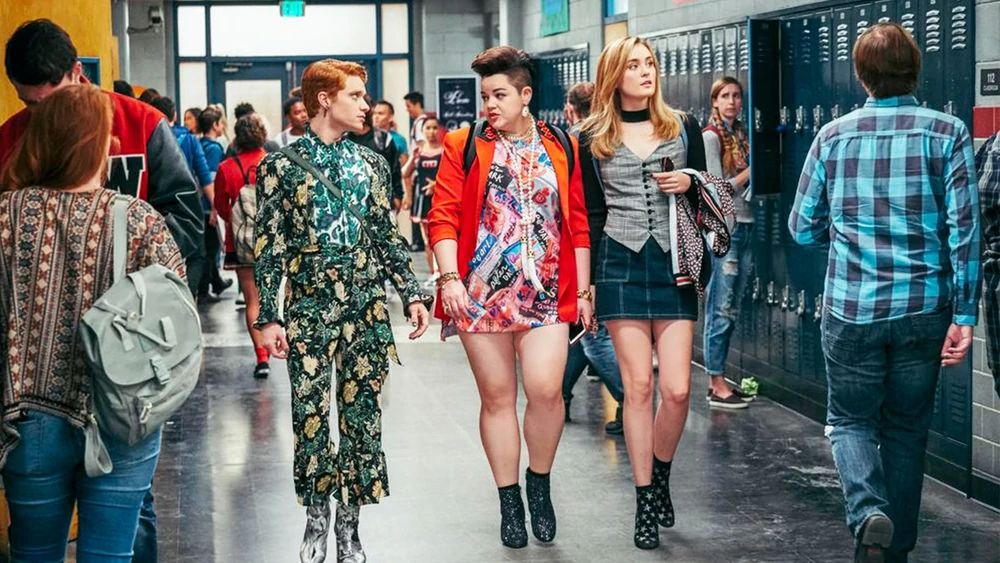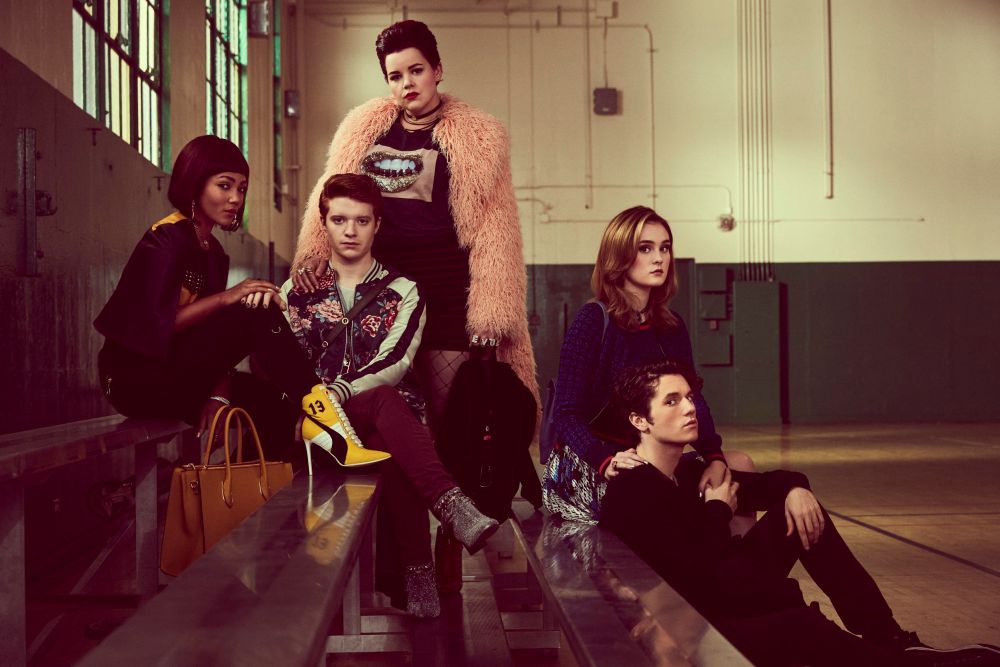Heathers: The TV series
I was a huge fan of the original movie, one which only improved with repeated exposure. We reviewed it not once but twice, then wrote in depth about the original script in Trash City #12 and it’s undeniably a case where the film could simply not be made today. It came out a decade before Columbine pushed school violence front and centre. While I can hardly call that “a kinder, gentler time,” its pitch-black humour regarding the topic would be considered thoroughly inappropriate these days. Though as writer Daniel Waters points out, “No one wanted it to be made in the late 80s, either.” Still, it became a musical, about which I have absolutely no interest. Then, in 2018, a TV series was made – the third attempt to do so – and that’s when the shit truly hit the fan.
The fuss began to build on the release of the trailer in January, which seemed almost calculated to press as many buttons as possible. The new “Heathers” being targeted by Veronica and J.D. were an overweight girl, a mixed-race lesbian and a transgender boy, previously known as “Heath”. No prizes for guessing how this went down with the Twitterati, especially those who forgot that, in the original movie, it was J.D. and, until a late change of heart, Veronica who were the villains. This meet-cute couple were cheerfully arranging the deaths of their classmates. It feels like the same people complaining, as the ones who idolize demonic killer Jennifer from Jennifer’s Body, and Tweet things such as, “If I had a friend who was terrorizing men, I would help her.”
“Why can’t we have more diverse representation on TV?”
<Heathers trailer drops>
“THAT’S NOT WHAT I MEANT!!!!”
It was, however, nothing compared to the reaction when the pilot episode was released on iTunes and Paramount’s site, as a “sneak peek” before airing on the channel. Matters were not helped by, two weeks previously, 17 people having been shot dead at Stoneman Douglas High School in Florida. The channel opted to push back the premiere to July, but the pilot was already out, and being eviscerated by… well, pretty much the same people who had complained about the trailer. Let’s pick some examples from the Wikipedia article on the show – albeit by sources who would appear to be incapable of realizing they are largely demonstrating, as we’ll see, the attitudes being satirized:
- The Daily Beast: “Plays precisely like that dreaded conservative fantasy—a fantasy for people who think society has gone too far toward acceptance.”
- Birth Movies Death: “A hateful, bigoted exercise in regression hiding behind the guise of dark comedy.”
- Hollywood Reporter: “A dark and almost reactionary undercurrent in which the disenfranchised aren’t being bullied, but rather are wielding identity politics and political correctness as weapons.”
To be fair, the fact the pilot was left to stand on its own was a big part of the problem, largely creating a set of false expectations. The first episode is, far and away, the one which mirrored the original movie to the greatest degree. In it, Veronica grows disenchanted with the trio of Heathers, and teams up with J.D. to kill Heather Chandler and fake it as a suicide. It borrows lines, scenes and musical cues from the movie, which make it seem less like a reboot than a copy, and that’s rarely a good thing. The best chunks were likely the idiotic behaviour of the adults, such as the teachers discussing the changing social dynamics, and lampooning with pinpoint accuracy how various news outlets report on Heather’s death:
- The Times: “Shocking Online Death Sparks Discussion.”
- Jezebel: “How the Patriarchy Killed Heather Chandler.”
- The Drudge Report: “Deceased Obese: Is Hillary to Blame?”
- The Post: “It’s SS Suicide for Nazi Fatty.”

The months passed. But in June, Paramount’s parent company, Viacom, opted to drop the show entirely, in part after another school shooting, this one in Santa Fe. As Waters had said when the show was originally delayed, “Oh, you’re going to wait for the week when there isn’t a mass shooting? Good luck with that.” It did come out in other markets, apparently without triggering any killing sprees, and after apparently failing to find another network for it, in October 2018, a hacked-down version of the show was eventually spat out on the Paramount network over the course of a week. Plans for a second series – to be called Heathers: Revolution, set in the 1700’s and revolving around Marie Antoinette, I kid you not – were scrapped. I can only feel this is a terrible loss to society.
It’s easy to satirize a right-wing bully. When you also slap around earnest progressives, that’s when you really earn your satire credentials.
Daniel Waters, writer of the Heathers movie
Enough backstory. What of the show? #NotMyHeathers. This was a tag started by the Twitterati, as they realized what they were getting was… different from the original movie. The show’s Twitter account gleefully pounced on this, reclaiming it as a badge of honour. And they’re right. [Spoilers, of necessity, follow for the rest of the show] While the first episode runs along similar lines, it takes an abrupt right turn at the end, with the resurrection of Heather Chandler, as her murder/”suicide” proves non-fatal. It’s here that we deviate sharply from the film. The next episode continues the change. With Chandler initially out of the picture, Betty Finn makes a play to take over. Heather McNamara, who has been outed both as a non-lesbian, and having a relationship with a teacher, ends up genuinely committing suicide, slitting her throat during the Chandler memorial at the roller-rink – at which the unexpected beneficiary shows up.
It’s probably here that we reach the series’s peak, with a truly gut-wrenching depiction of a teenager taking their own life, in a world that simply doesn’t care about them. It’s considerably more impactful than McNamara’s suicide attempt in the movie, which consisted of grimly trying to choke down a handful of pills in the bathroom, and went from zero to… well, back to zero in barely a couple of minutes. One of the strengths of a series compared to a film, is that you have time to explore things at greater length, and this arc is a demonstration of that, utilized to its full potential. The episode as a whole is very well assembled, not least for its use of music. Whoever got permission to use Beyonce’s Halo is a genius. One wonders quite how much her publishing company were told: “Yeah, it’s just for a scene at a roller-skating rink…”

The problem is that, from there, the show probably has only one way to go, and it’s not up. For the flip side of the series vs. movie coin, is that the latter can be considerably more intense, and go full-bore for the audience’s jugular, in a way a show can’t hope to do. Oh, individual episodes can reach peaks (we’ve seen that in everything from Game of Thrones to Buffy): it’s just not sustainable over 10, 13 or 22 parts. Some elements of it still work though. I think I was most impressed by the character arc of Heather McNamara, whose “rebirth” helps spawn a series of changes over the course of the series. These are likely greater than those written for Veronica, who ends up more or less in an on-again, off-again relationship with J.D, that isn’t particularly interesting. The actors aren’t Winona Ryder and Christian Slater either.
However, all the teenagers are, at least, rounded characters, with good and bad qualities. Adults? They may be the real target of the show, being universally shallow, targets of mockery. Despite the media comments above, it is certainly poking fun at both sides. Sure, as in the original movie, Pauline is an unrepentant hippie (now transformed into your typical SJW); yet the show also mocks savagely the right-wing suggestion that teachers should be armed. Which brings me to the finale, as yet still never aired in America (the show in the US ending on a cliffhanger after nine episodes). This goes back to the original version of the film written by Waters, in which J.D. succeeded in blowing up the school, followed by a prom in heaven. New Line Pictures’ executives nuked that, according to the writer saying, “No way. We can’t make a satirical movie about teenage suicide in which the people actually kill themselves.”
Here, J.D. initially wants to postpone the atrocity, because a school shooting the same day stole his thunder. However, Veronica forces him to go through with it, the two shooting each other in the school basement. Again, this version of Veronica may be closer to the one originally envisaged by Waters: “In my initial drafts, Veronica was much more evil and twisted. I referred to her as a female Travis Bickle from Taxi Driver.” Heather McNamara, thrown out of prom for having too short a skirt, is the only student to survive, Everyone else is at the prom in heaven, and are very happy there, getting what they wanted… except for J.D. and Veronica, who are invisible and unable to interact with anyone, or even each other. They end up locked outside, apparently enduring hell, which means being utterly alone for all eternity. It’s a surprisingly Judeo-Christian ending to a show, which did not feel like it had much religious faith.
All told, it would definitely have benefited from stronger performances in the roles of Veronica and J.D., and this is likely the area where it falls shortest of the original film. However, the writing is crisp, occasionally memorably so, even if the shoe-horning in of lines from the movie sometimes seems forced. I liked rather than loved the show, mostly for being so radically different from anything else to come out of the American TV landscape. That’s frequently an excuse for blandness. Whether or not you agree with what it’s trying to say, “bland” is definitely not something which can be said about Heathers.
